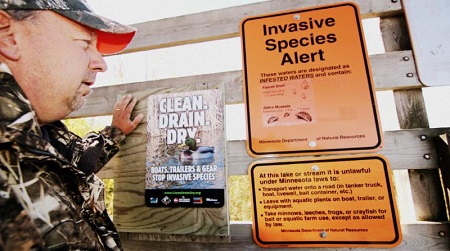 While anglers are often enlisted to help fight the spread of harmful aquatic invasive species, waterfowl hunters need do their part as well. Good news is, it’s as easy as “Clean, Drain and Dry.”
While anglers are often enlisted to help fight the spread of harmful aquatic invasive species, waterfowl hunters need do their part as well. Good news is, it’s as easy as “Clean, Drain and Dry.”“Duck and goose hunters are among the most dedicated conservationists around, so it’s natural that we want to help stop exotic invaders from overrunning our lakes, marshes and backwaters,” says veteran waterfowler Scott Glorvigen.
Each autumn, he, and equally hard-hunting twin brother Marty, pursue ducks and geese across the Upper Midwest. Also diehard anglers, they traverse the heartland with similar passion pursuing walleyes and other game fish, both through the ice and in open water.
“Too many times, we’ve seen firsthand the ill-effects invasive species can have on the watersheds that are so critical to the future of hunting and fishing,” adds Marty.
In a nutshell, invasive species are non-native plants and animals that can destroy fish and wildlife habitat; damage hunting, fishing and boating gear; and limit access to prime fishing and hunting areas. In the Great Lakes alone, thousands of waterfowl die each year due to parasites and avian botulism carried by gobies, zebra mussels and faucet snails.
“Many outdoors enthusiasts are familiar with zebra mussels, but the list of invasive species includes a wide variety of invaders from Quagga mussels and Eurasian watermilfoil to spiny water fleas and rusty crayfish,” says Scott.
 |
|
It looks like great blind material, but invasive phragmite grass can choke out beneficial native wetland plants, destroying waterfowl habitat.
|
“Once they become established in a lake, river or marsh, they can wreak havoc on the ecosystem,” Marty notes. “Non-native plants such as phragmites grass, for example, can choke out native wetland plants, reducing critical waterfowl habitat. It may look like great blind-making material, but using and transporting it spreads big problems.”
To help prevent invasive species from spreading, waterfowl hunters (and other boaters) are reminded to follow these simple steps:
Clean your boat, trailer, motor and equipment by removing all visible plants, seeds, mud, mussels and other animals before leaving any water access. Be sure to check your dog and decoy lines.
Drain the water from your duck boat, bilge and motor by removing drain plugs and opening all water draining devices. Note: many states and provinces mandate such steps when leaving public accesses.
Dry your gear for at least five days before going to other waters and landings, or spray and rinse it with high-pressure and/or hot water.
Wildlife Forever conservation director Pat Conzemius says waterfowl hunters have additional considerations due to their specialized gear.
“In addition to the standard boating equipment, we hunters use decoys, waders and push poles, along with vegetation for our blinds,” Conzemius explains. “These items may contain water, seeds and mud where invasive species like zebra mussels and invasive snails can hide.”
Conzemius recommends cleaning all equipment, even the boat, before leaving a hunting location. He also cautions hunters at infested sites to avoid using non-native plants such as exotic phragmite grass for their blinds, which increases the risk of accidentally spreading these marsh-clogging invaders.
“If unsure, be sure not to transport,” he adds. “You could get ticketed.”
For more information on how hunters can help stop the spread of invasive species, the Glorvigens recommend visiting Wildlife Forever the U.S. Forest Service or their local DNR website.
“Conservation never sleeps,” says Scott. “Join us and Wildlife Forever in protecting fish and wildlife from invasive species.”
